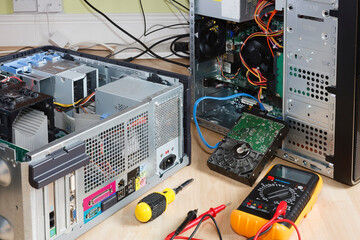NSA provides comprehensive repair solutions for a wide range of consumer electronics and appliances, including televisions, computers, and other digital equipment. Professional maintenance services ensure optimal functionality and longevity of electronic devices while safeguarding data integrity.
Market participants focus on expanding service networks and enhancing customer interaction. They are leveraging advanced diagnostic tools to guarantee reliable repairs and compliance with manufacturer standards.

1. Preventive Maintenance
Preventive maintenance services help businesses minimize equipment failure and downtime. They can include a range of tasks such as system upgrades, data backup checks, hardware inspections, and software update installations. These routine tasks are also vital for ensuring operational safety and regulatory compliance. Preventive maintenance schedules are typically based on manufacturer recommendations and operational insights.
A centralized maintenance management system (CMMS) is a key tool for implementing preventive maintenance plans at scale. It allows technicians to easily access the information and tools they need, including work orders, inventory, and asset information. Using this data, technicians can create customized preventive maintenance schedules for each piece of equipment in their facility. The CMMS also helps managers track inspection results and maintenance history.
As a result, companies can keep accurate records of all maintenance activities and identify areas of improvement. The CMMS also helps reduce human errors by guiding technicians through the process of inspecting and maintaining equipment.
The global consumer electronics repair & maintenance market is projected to reach USD 6.6 billion by 2024. This is largely attributed to the growing adoption of sophisticated consumer electronics and broader technology acceptance, leading to higher demand for maintenance services. In addition, the shift towards sustainability has also encouraged consumers to opt for repairs rather than replacements, further driving the industry. Moreover, the Asia Pacific region is a major manufacturing hub for consumer electronics, fostering a robust network of authorized service centers and enhancing market prospects.
2. Repairs
Despite the rapid pace of technological advancements, many consumers favor repairing their electronics rather than purchasing new devices. This trend is due to the high cost of new products, a shortened product lifecycle, and the need for specialized services such as software repair and hardware replacement. A growing number of government programs offer financial incentives to promote repair instead of purchase, thus lowering the overall costs of electronic maintenance and minimizing e-waste.
The consumer electronics repair and maintenance market is driven by a global focus on sustainability and a desire to reduce electronic waste, as well as rising user demand for dependable electronic equipment. North America is a key player in this market, with broader technology adoption and a robust manufacturing sector, resulting in an established network of authorized service centers and repair facilities. Europe’s emphasis on extended producer responsibility is also supporting the market, as it encourages consumers to repair their products rather than discarding them.
Across all regions, online repair bookings and e-commerce platforms have transformed the way that consumers engage with their consumer electronics maintenance providers. These platforms encourage competition amongst service providers and enable consumers to access expert repairs that are both affordable and convenient. Meanwhile, the popularity of Do-It-Yourself (DIY) repair kits and online tutorials has empowered users to fix their own devices without the need for professional help.
3. Upgrades
Computer repair often involves upgrading or enhancing various aspects of the system. This can include increasing memory capacity, replacing older or faulty components, improving cooling systems, and installing additional hardware devices. In addition to these upgrades, computer repairs also sometimes involve data recovery services. This entails using special techniques to retrieve lost or inaccessible data from storage devices such as hard drives and solid-state drives.
The Upgrade Agent / Appliance Software action automatically upgrades computers or virtual appliances that are out-of-date according to version control rules you have configured. This action is available on the Computers tab in the main pane.
4. Diagnostics
Electronic devices are a critical component of business operations. They provide connectivity and functionality, optimize workflows, and store sensitive information. But as devices become more sophisticated, they require expert maintenance to prevent software errors and hardware failures that can slow systems down or cause them to fail altogether. Regularly addressing problems like outdated software or excessive data can greatly impact productivity and profitability.
To meet this demand, companies are leveraging technology to streamline the repair process and offer more convenient services for clients. For instance, many appliance repair companies use software that allows technicians to communicate directly with appliances, access diagnostic history, and perform real-time tests. This reduces diagnostic time, increases efficiency, and improves customer satisfaction.
Another way to enhance the repair and maintenance process is by integrating software with existing tools. This allows technicians to complete repairs faster, saving both time and money. This is especially useful in addressing complex problems, such as refrigerators that are not cooling properly or washing machines that are leaking.
A robust diagnostics system can help businesses reduce repair costs, save on labor hours, and increase revenue. To ensure that the software meets these needs, it should have a clear interface design and easy navigation for technicians to find features quickly. Additionally, it should be scalable with different user roles and permissions to accommodate changing business requirements.